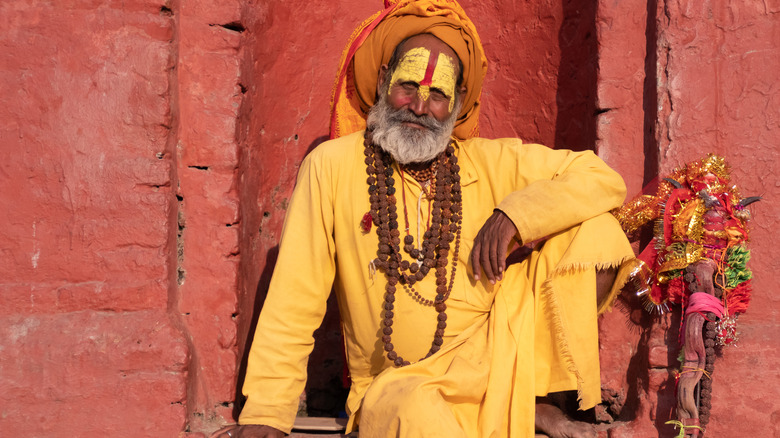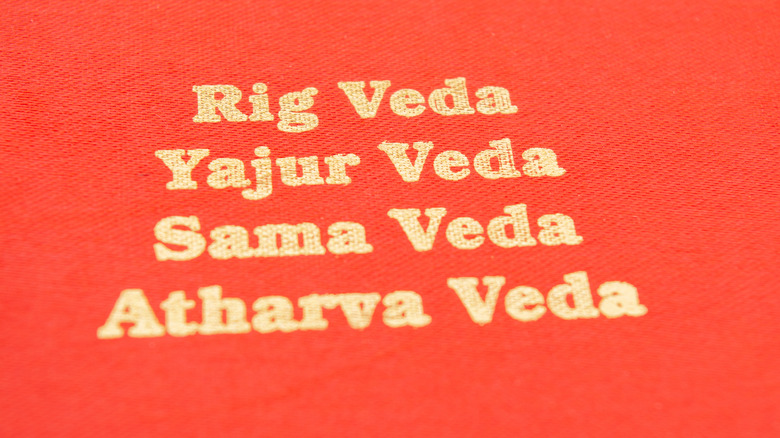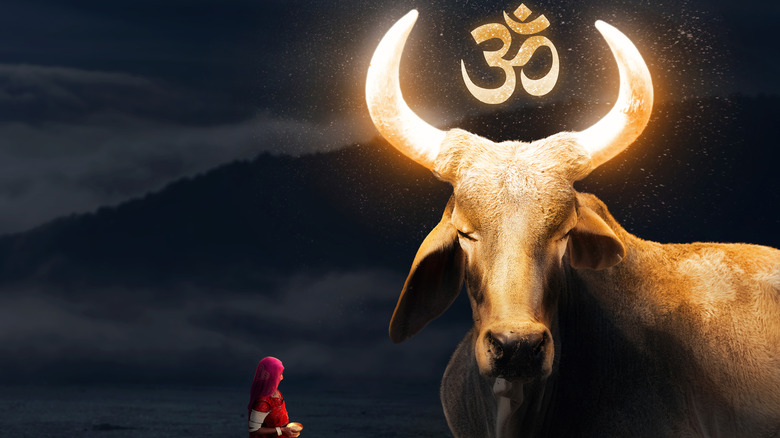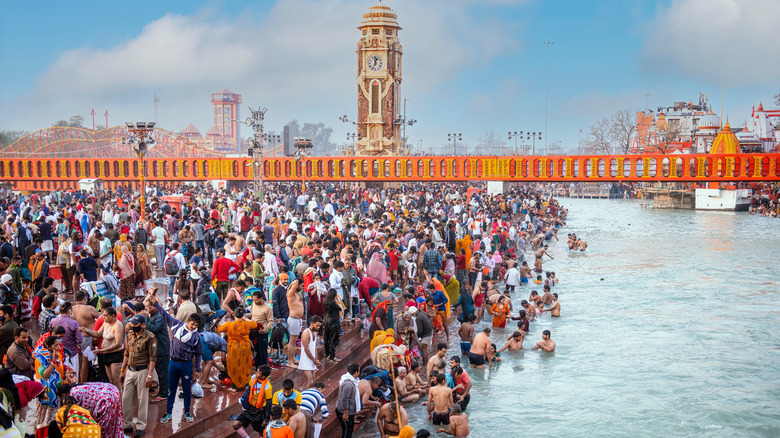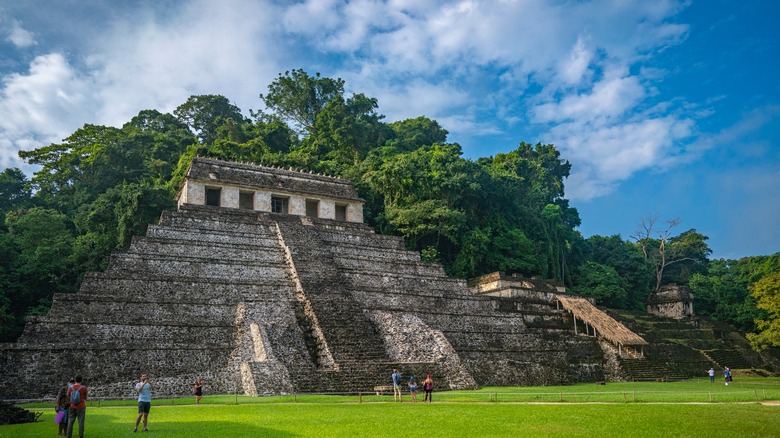The Untold Truth Of Hinduism
Hinduism is probably one the most misunderstood religions in the world. In fact, it is not truly a religion — and Hinduism is a word conceived by British colonialists. Nevertheless, behind the term there is complexity hard to understand to a passing student, as it hides truths as old as time. Even time is not understood in the same manner as it is in other philosophical belief systems, and many different scientific discoveries, like the law of gravity and the existence of atoms, can be connected to ancient Hindu thinkers.
Its core concepts speak about interconnectedness and the eternal nature of the soul, which is valued far more than a material body or matter. Reincarnation allows people to fix the wrongdoings of the past, but also binds humans to life on Earth, until they achieve salvation. To reach salvation, Hinduism developed numerous methods — including yoga, the exercise of body and mind — to help the human being understand the secrets of nature.
Here is the untold truth of Hinduism.
Hinduism is the oldest school of thought in the world
It is not known exactly where and when Hinduism started, as it combines different philosophies and practices that developed throughout history. Scholars generally agree that it dates back to sometime between 2300 B.C. and 1500 B.C. Surfacing among the people of the Indus Valley near Pakistan, the philosophy was soon mixed with influences from elsewhere, mostly with the culture of Indo-Aryan people who migrated to the area around 1500 B.C. At that time, the Vedic Period was introduced, when sacred Vedic texts were written (before that, the teachings were passed on orally), and Hinduism became more connected with different types of rituals. This period lasted until about 500 B.C. and was followed by the Epic, Puranic, and Classic Periods, lasting until A.D. 500. Deities such as Devi and Vishnu were introduced (via History).
The word Hinduism didn't exist until the 19th century, explains academic David N. Lorenzen (via Cambridge University Press), when the term was popularized by British colonialist scholars. For this reason, some researchers claim that Hinduism as we know it doesn't really exist, as it is a Western construct for something that is far too complex and broad to be covered with a unified term. Despite the disparities between the actual practice of Hinduism and political definitions, which often cause conflict, 1,093,780,000 people in India define themselves as Hinduists, which is 78.9% of the whole Indian population.
Hinduism is not a religion
In a world that often thinks in terms of only two opposing viewpoints — either science or religion — it is hard to understand Hinduism in all its complexity. It is not technically a religion, as it has no specific founder, there are no prophets, and the core principles behind it evolved into many different branches of Hinduism, from physical practices such as yoga to complicated philosophical texts. As per yogi guru and mystic Sadhguru, Hindu is really a geographical term deriving from the name of the land Sindhu and doesn't say much about faith or spiritual beliefs. The concept of Hinduism, as we call it, is all about discovering one's power. Sadhguru calls it "a science of salvation," far from an organized religion, as it is sometimes promoted today. The main essence of Hinduism is that its teachings are attainable to anyone — there are no priests or other gatekeepers of the sacred knowledge, as is common in other, actual religions. Anyone can practice rituals of Hinduism or read the sacred texts, despite their race, other beliefs, or nationality.
The real name of Hinduism and its essence is sanatana dharma, the set of core duties one needs to implement in their life. This includes goodwill, patience, self-restraint, and self-discipline, along with avoidance of violence. Sanatana dharma is different from svadharma, a set of duties specific to an individual and dictated by one's social position, both among family and in public life (via Britannica).
There is no god in Hinduism, but everything is sacred
Because Hinduism is not a religion, there is no one god in its teachings. Instead, divine presence exists in anything. It is not separate from humans or other beings — or nature! The sacred texts of Hinduism, the Upanishads, speak about Brahman as the consciousness behind everything — something other religions would define as God. But this "god" is not separate or of higher position than others. It is omnipresent, and every person can find it in themselves. As the teachings of Hinduism developed, specific manifestations of ethical values and principles evolved as well. These are the numerous gods and goddesses known in different traditions of Hinduism, such as Shiva, Kali, Saraswathi, Krishna, and others. But they aren't supreme beings — just personalized characteristics so people can identify with them more easily (via Britannica).
There are five main ways that people can incorporate Hinduism in their lives: through doctrine, practice, society, story, and devotion. First are the teachings of the sacred texts, while the second includes practices that support the teachings, like rituals. The third one involves the structure of society, and this is the most disputed one, since today's caste system is often repressive and unjust. The stories are the fourth important part of Hinduism, as many instructions are passed on in the form of stories about gods and humans. Devotion includes many worshiping practices, all expressing love for the divine (per Britannica).
For Hinduists, the soul is eternal
The most important principle of Hinduism views the soul as something eternal, so when someone or something dies, they are reincarnated, or reborn, again and again — this cycle is named samsara. The circumstances of a person's rebirth depend on his karma — the sum of his previous deeds. For that reason, Hinduism puts less emphasis on the material world and earthly pleasures, as one earthly life is nothing compared to the long life of the soul. The ultimate goal every soul strives for is moksha, the end of reincarnation and final unity with the universal consciousness. For this, the soul needs to not only be relieved of its karma, collected through centuries of reincarnations, but also completely non-attached — to one's body, earthly possessions, and even loved ones (via BBC).
This core concept of Hinduism corresponds to the law of conservation of energy, as per Hinduism Facts. According to Anne Marie Helmenstine, Ph.D. (per ThoughtCo.), this scientific principle explains that the universe contains a certain amount of energy, and this energy only changes its form. It cannot be destroyed or created anew, but it can pass from one form to another. Just like souls!
Hinduism does not deny other religions
Because Hinduism is not a religion itself, but a school of thought, it doesn't exclude other religions. On the contrary, one can believe in a different god, but still follow the practices of Hinduism. As explained by political theorist Bhikhu Parekh (via Global-e Journal), one of the core beliefs of Hinduism is the premise that beliefs as such are not that important, as long as they help the person lead an ethical life that encompasses a set of duties, including responsible living toward oneself and others. What most people perceive as reality is only a fraction of what actually exists in the universe, so it would be wrong to say only one view of this reality is the right one.
It has to be noted that Hinduism does see other religions as inferior, but only because they are dogmatic, claiming perfection along with criticizing and punishing other religions. In Hinduism it is not about one human against others, but a dialogue between a human and the universe, so one's responsibility is to explore it and equip oneself to be capable of this exploration. Yogic gurus and holy men, people close to the Brahman (universal consciousness) in Hinduism, didn't get there by birth or position. They became gurus through a lifetime (or many lives!) of self-discipline, thought, and practice.
The core principles in the Vedas oppose Western neoliberalism
Because Hinduism sees humans as continuously reincarnating and evolving, it doesn't agree with Western egocentric ideas of one life without consequences. It calls for nonviolence and strives for spiritual abundance, not material wealth, presumably through an ascetic life (via Huffington Post).
Hinduism does not support exploitation of the natural environment for profits, either, as it promotes simple, sustainable living and describes the earth as a living being, connected with humans through various means. Protecting the environment and all living beings is one of the highest duties, or dharmas, that one can undertake while living on Earth (via Hindu American).
Hinduism sees Western liberalism as "an inherently flawed doctrine," explains Ashay Naik for India Facts, since the modern capitalistic age kept the worst parts of feudalism and erased what some perceive as the good aspects. Neoliberalism did not lead to a free and egalitarian society, but to a community driven by competition and greed.
Hinduism understands time differently
Time is understood differently in Hinduism, as it is not linear, but circular — returning to the same point again and again. For Hindus, time equals divine presence, and the past, present, and future exist in parallel. Therefore, in Hinduism, time and space are just illusions. By believing in concepts like time, we submit to this illusion over and over again, until we conquer it and become immortal, as per Learn Religions.
According to Hindu thought, the cycle of humanity repeatedly travels through four different eras, called yugas. A thousand cycles of the four yugas make up one kalpa. Yugas are calculated meticulously: One yuga cycle lasts 4.32 million years, making a kalpa 4.32 billion years. Each yuga is further broken down into divine years. One divine year consists of 432,000 years on Earth, and each yuga has its own number of divine years. It starts with Satya Yuga, the Age of Truth, lasting 4,000 divine years. The next 3,000 divine years make up Treta Yuga, while the next one, Dwapara Yuga, is even shorter: 2,000 divine years. The last one, Kali Yuga, lasts for only 1,000 divine years, which is quite reassuring, as this is the worst one.
The four yugas represent four stages of consciousness evolution. In each era, humanity forgets its sacred origins a little bit more, bringing more negative karma. According to Hindu calculations, humanity is currently in Kali Yuga, the Age of Darkness. When this comes to an end, the universe will be destroyed and recreated (via Learn Religions).
Numerous methods evolved to support the Hindu view of a human being
Hinduism describes a human body not just as a physical mass, but an energetic body as well. According to Thrive Global, there are three main bodies: physical, astral, and causal. The first is the one we can see and feel, and it's best kept with proper nutrition and exercise. The other two are trickier, as we can't see them, but they affect us substantially. The astral one, or the subtle body, consists of life force (prana), which can be affected by emotions, thoughts, and actions. The consequences can be seen physically, as this body oversees breathing, metabolism, and blood flow. The causal body is even subtler than the astral one, as it carries memories, past thoughts, and emotions, even from previous lives, so while it has a massive effect on a person, it is hard to reach. Because the goal in Hinduism is to manage all three bodies in accordance with spiritual truths, there are numerous ways to support the body, mind, and soul: ayurveda, pranayama, yoga, meditation, astrology, martial arts, and many others.
While Western science continuously rejects this view of a human body, it's slowly catching up with these ancient truths. There are numerous studies proving the benefits of regular yoga practice, as it reduces depression and helps to alleviate stress. Yoga does not only affect mental health, but it also reduces inflammation, while yogic breathing, pranayama, positively affects "the neurocognitive, psychophysiological, respiratory, biochemical and metabolic functions” of the body (via ScienceDirect).
It has two main symbols, and one of them is the swastika
There are two recognisable symbols of Hinduism: Aum and the swastika. The first is popular all over the world and is often used as a brand logo for different wellbeing practices, while many people wear it as a pendant or even tattoo it on their skin. A less known fact is that the Aum symbol — sometimes called Om or Ohm — represents the sound of the universe, the essence of Hinduism. Aum was there when the universe was created, and its frequency is what sets the whole cosmos in motion (via Springer Link).
The other symbol, the swastika, is even more widely recognised, but not for the right reasons. Appropriated by the Nazis, the swastika's meaning changed from wellbeing and prosperity to death. It wasn't just Hindu people who knew the swastika 7,000 years before Adolf Hitler; the symbol was found all over Europe and Asia, in homes and places of worship alike. It appears in European pagan religions, Buddhism, Jainism, and other cultures. When archaeologist Heinrich Schliemann brought attention to swastika symbols found in ancient Troy in the 19th century and the symbol became popular as a good luck charm, no one could predict what would happen just a few decades later. For Hitler and his collaborators, the swastika turned into the symbol of Aryan superiority, soon decorating Nazi uniforms and later the Third Reich. For this reason, the swastika is still forbidden in Germany and some other European countries, as per Holocaust Encyclopaedia.
Lots of scientific concepts originate from Hinduism
Hinduism never opposed science. On the contrary, many scientific truths that we know today as modern discoveries were already written in Hindu texts or by different Hindu practitioners throughout history, reveals Detechter. There is even apparent documentation of an atomic explosion in the Mahabharata epic poem, while the unusual radiation activity near the city of Jodhpur in Rajasthan has led some to speculate about an atomic eruption 8,000 to 12,000 years in the past.
In the Vedas, one verse describes the oval shape of galaxies, while Earth was considered round — long before Pythagoras. Hindu mathematician Acharya Aryabhatt wrote about heliocentrism of the universe 1,000 years before Copernicus, and Hindu astronomer Bhaskaracharya calculated how long it takes for Earth to circle the sun, along with other discoveries in astronomy. The Hindu astronomical text known as the "Surya Siddhanta" preceded Newton and his law of gravity by 1,200 years, correctly stating that the force that keeps planetary objects in line is the phenomenon we now know as gravity. Even the atomic theory, dismantling matter into atoms, wasn't John Dalton's discovery. Hindu philosopher Acharya Kanad, predating Dalton by 2,600 years, spoke about the invisible element anu, which forms everything in the universe.
While ayurvedic medicine is still disputed in modern science, there is no doubt that Sushruta, a Hindu doctor, executed medical procedures that correspond to contemporary medicine. He conducted rhinoplasty, brain surgery, and cesarean births, along with writing a book, "Sushruta Samhita," where he described 300 procedures and even 125 surgical tools.
The Kumbh Mela festival is the largest human gathering in the world
Hinduism loves a good celebration, and many festivals, such as Choli and Diwali, have become world famous. But there is one festival that is larger than any other: the Kumbh Mela. As per Britannica, the festival lasts for weeks and is visited by over 200 million people — sometimes 50 million in a single day! Everyone who describes themselves as Hindu visits the festival, including the holy men (who often live in seclusion from society), representatives of religious institutions, and even politicians. The festival is organized four times in a 12-year period, taking place in four river locations across India: Haridwar, Ujjain, Nashik, and Prayagraj. The times and places of the festival are calculated in correspondence to positions of the sun, the moon, and the planet Jupiter, taking place in each location at the time when the three celestial bodies enter a specific astrological position.
While the person credited for the beginnings of this festival is a vedic scholar Adi Shankara, living in the eighth century, there is also a myth connected to the festival. When gods fought over the pot of immortality elixir, amrita, a few drops got spilled in four places where the festival is held. When the time is right, these places, which are located next to rivers, become sacred again, allowing Hindu people to bath themselves in amrita.
The ancient Hindu and American Indigenous civilizations have many things in common
According to Sanskriti Magazine, several academics proved that there are many similarities between the culture of the ancient Hindu people and the ones that spread out through North, Central, and South America. Ancient Mayan people practiced similar rituals to ancient Hindu communities, as well as dividing their society into a caste system. Both knew the same astronomical constellations, and swastika symbols were found in the ashes of an ancient city near Mexico City. They played games that were very much alike and decorated their temples, as well as themselves, in a similar manner.
The Mayan ancient temple of Palenque has many architectural similarities with those in ancient India, and several of the Mayan languages — Nahuatl, Zapoteca, and others — could have originated from ancient Hindu lands. Lord Vishnu in Hinduism is frequently depicted with the serpent Ananta and the eagle Garuda, two symbols commonly used by the ancient Aztecs and their feathered god Quetzalcóatl, or ancient Mayan people and their serpent god Kukulkán.
